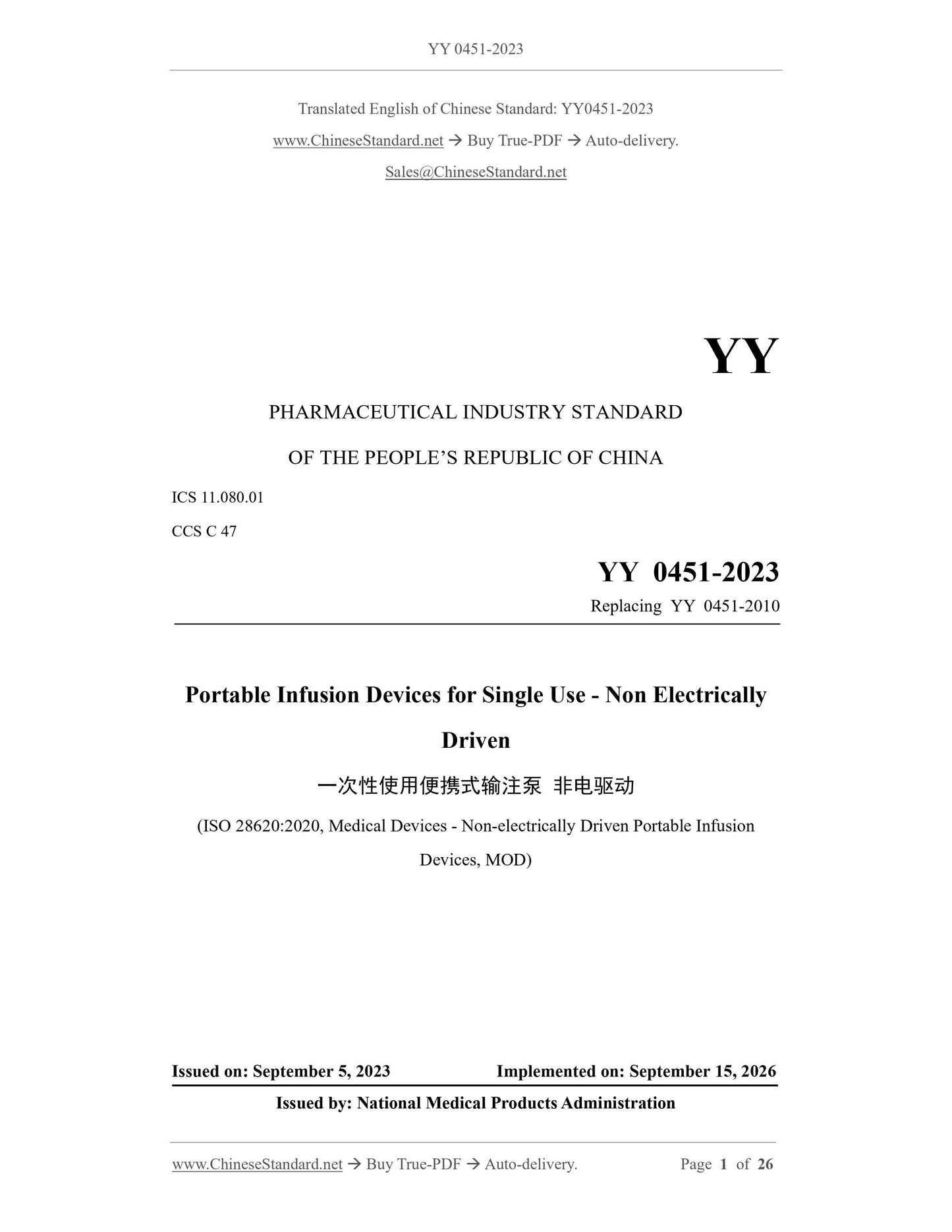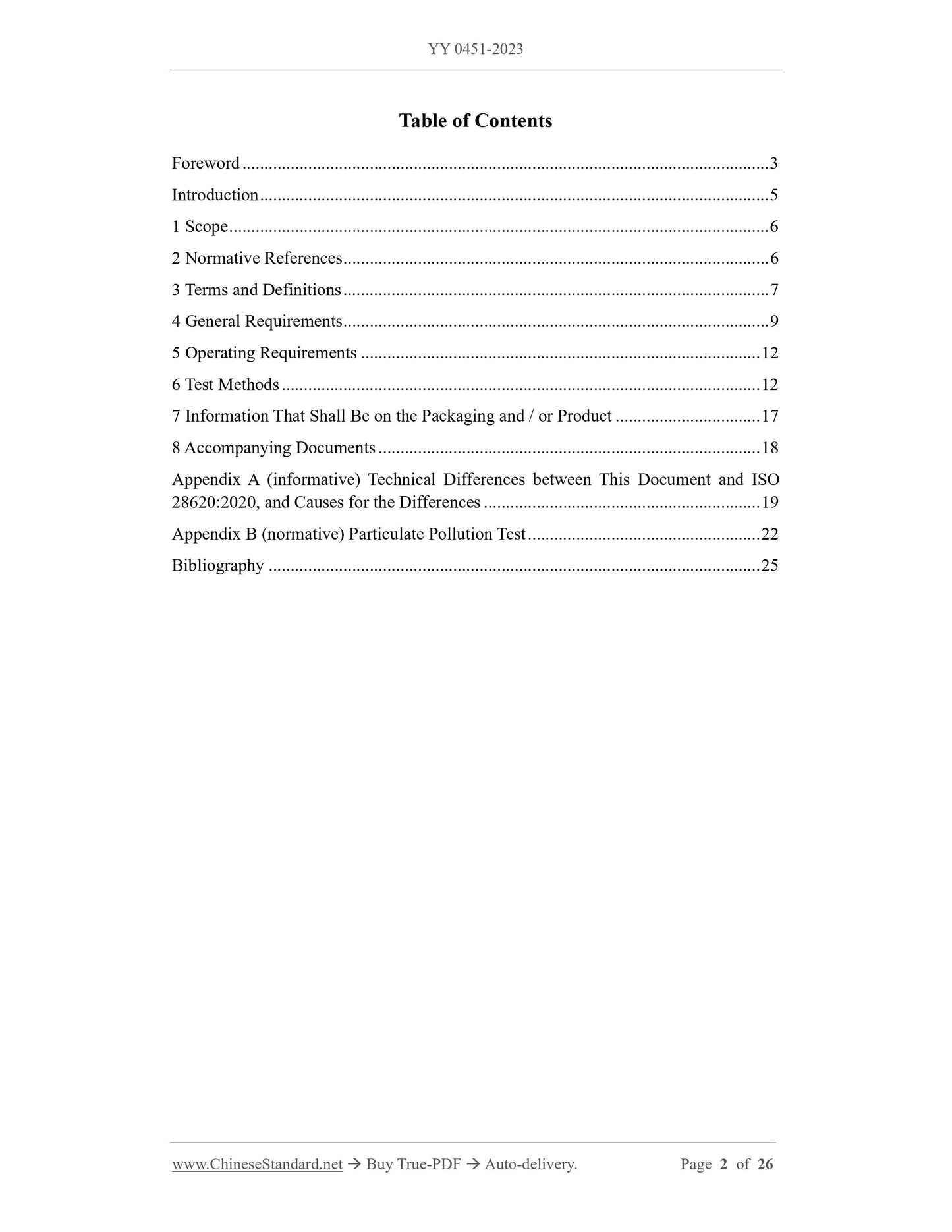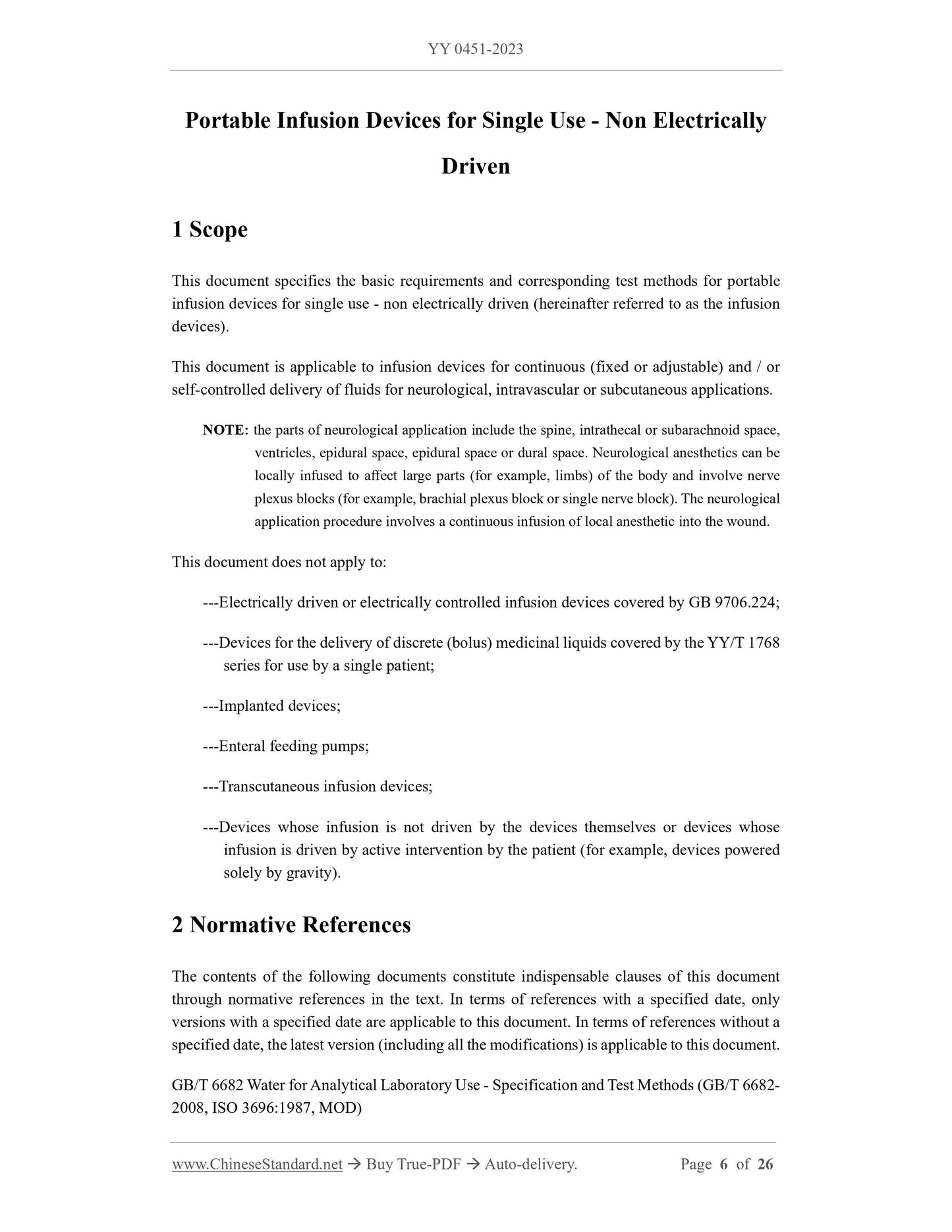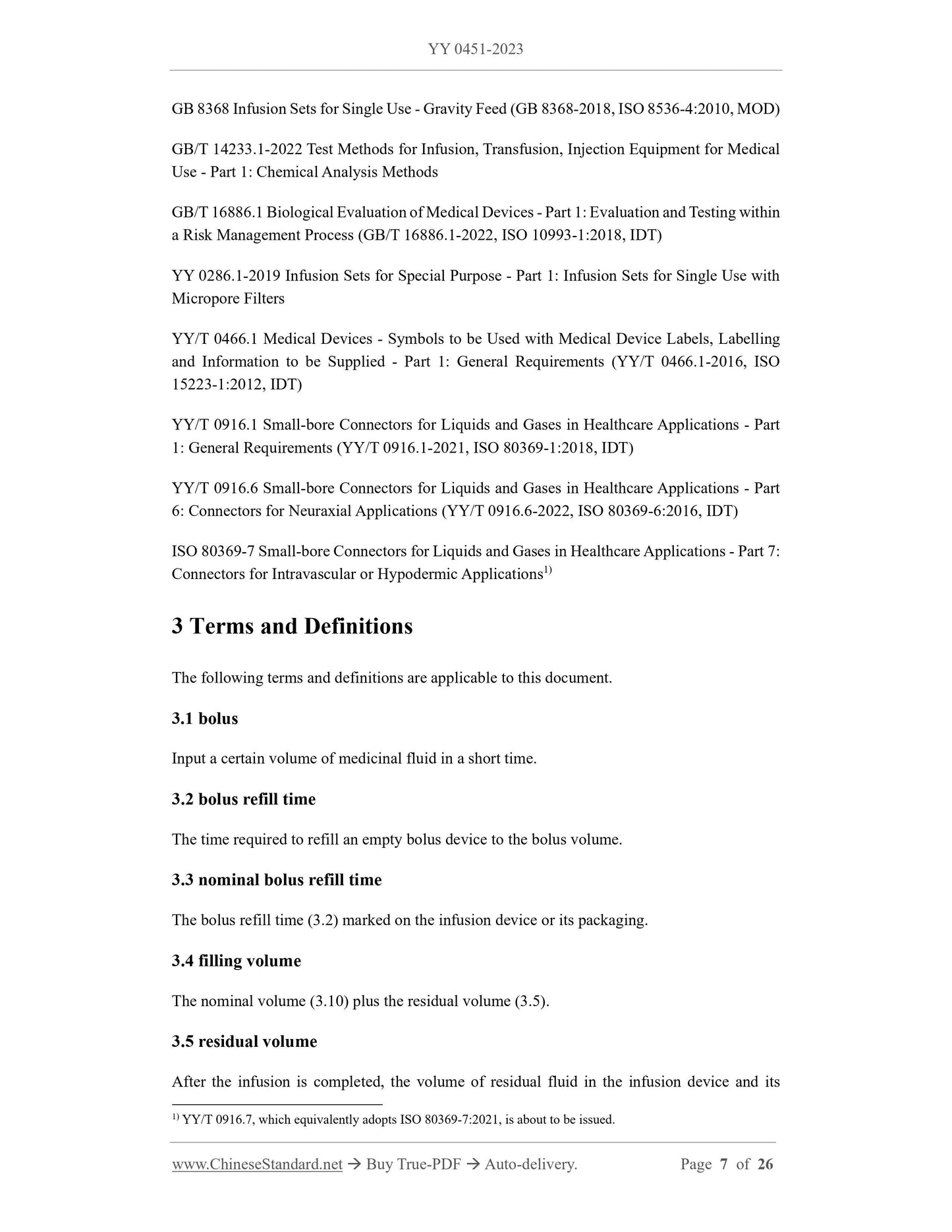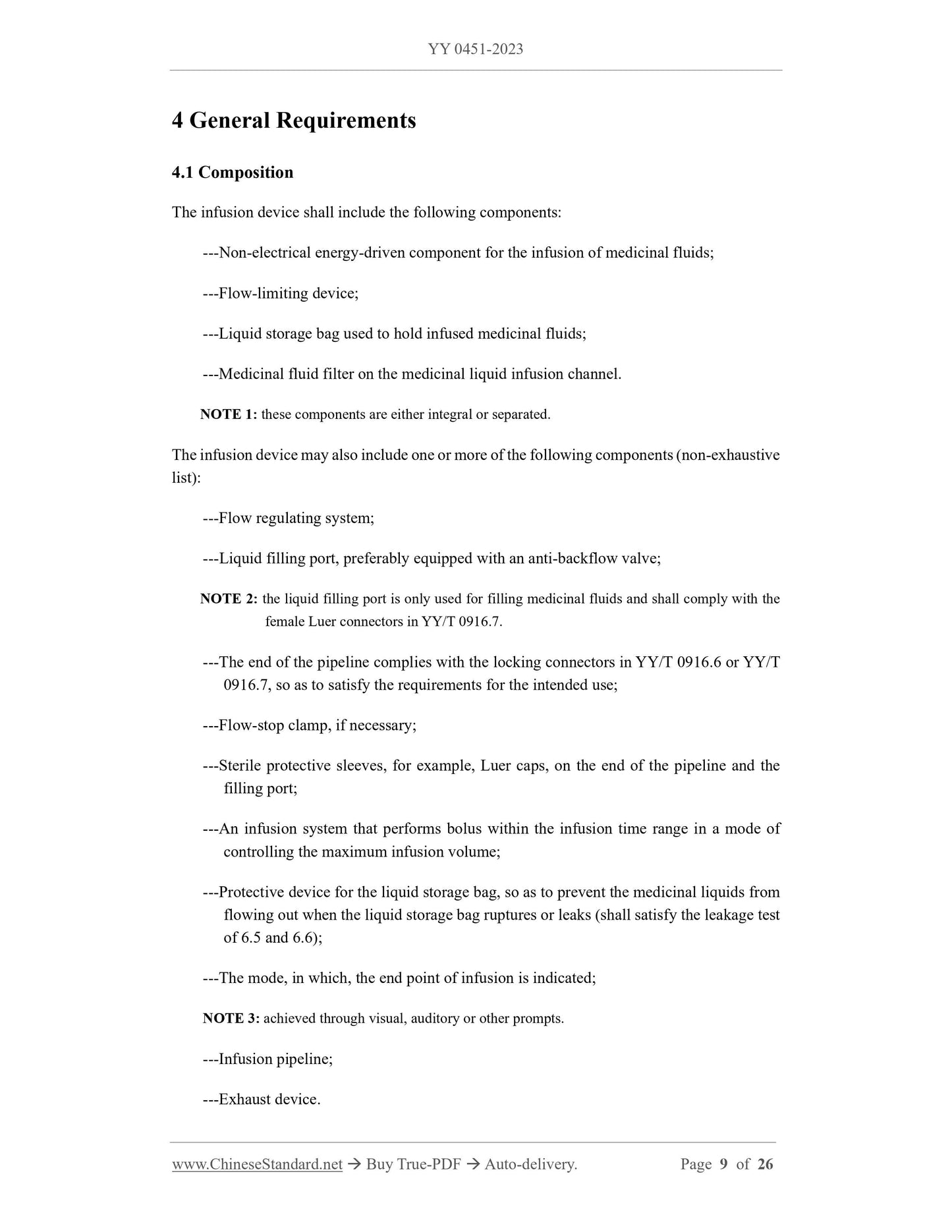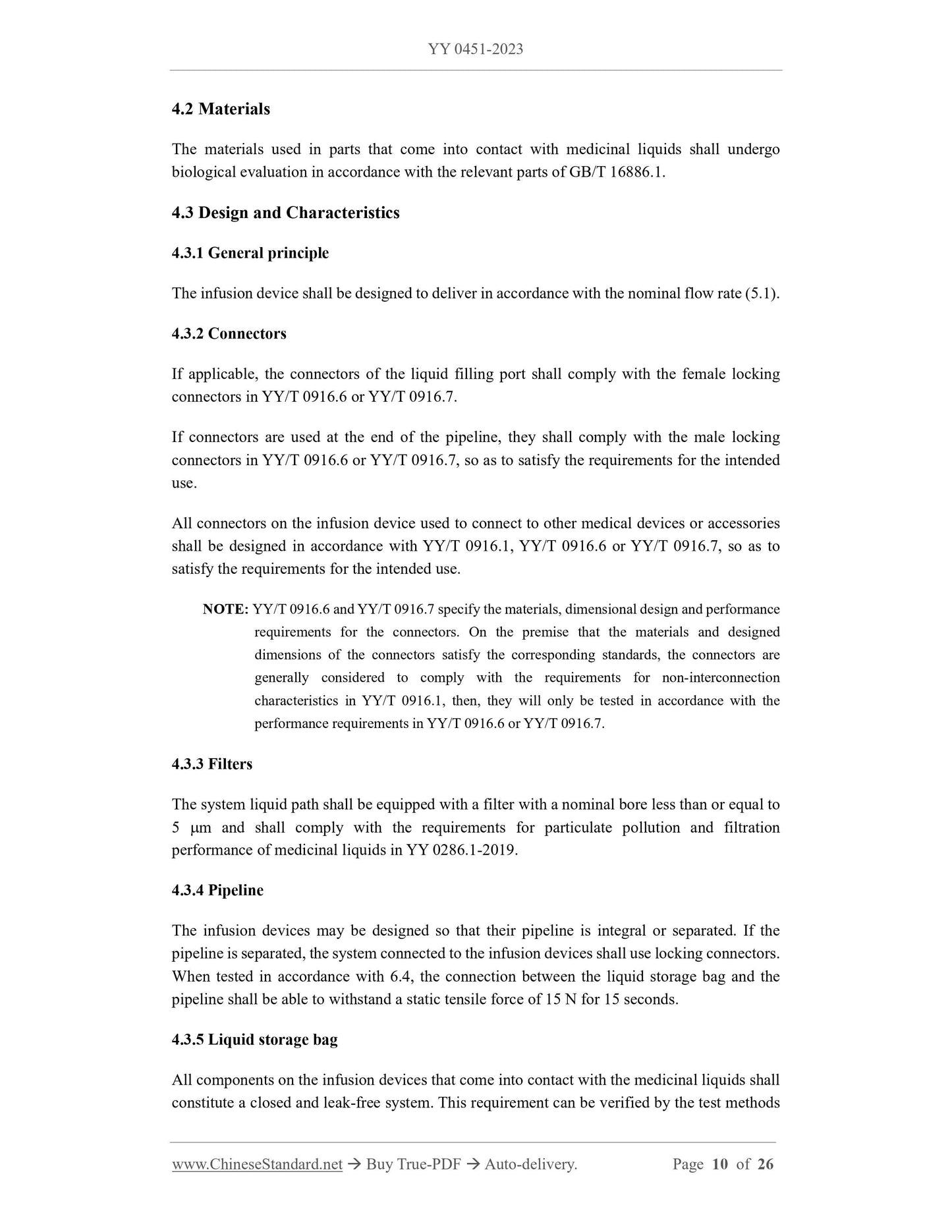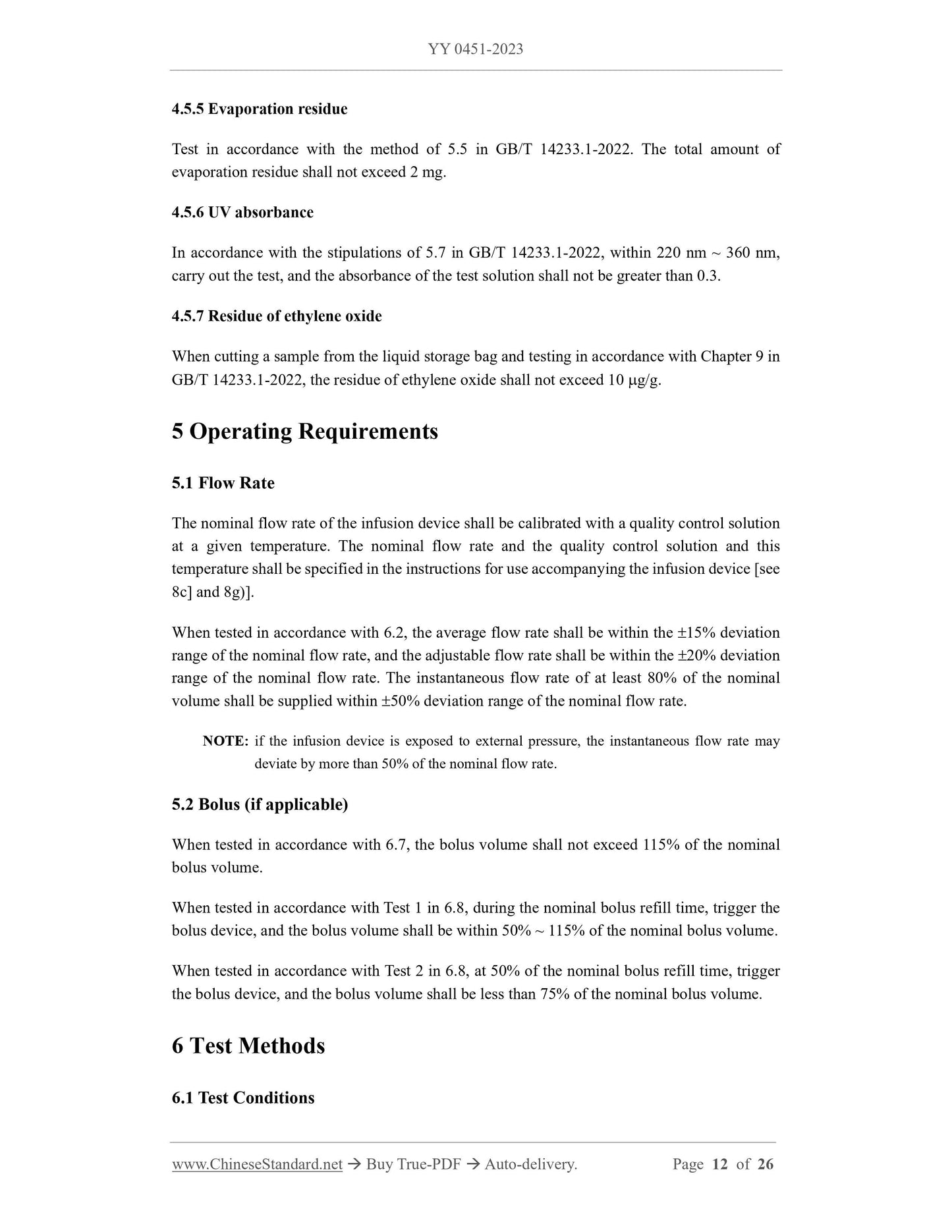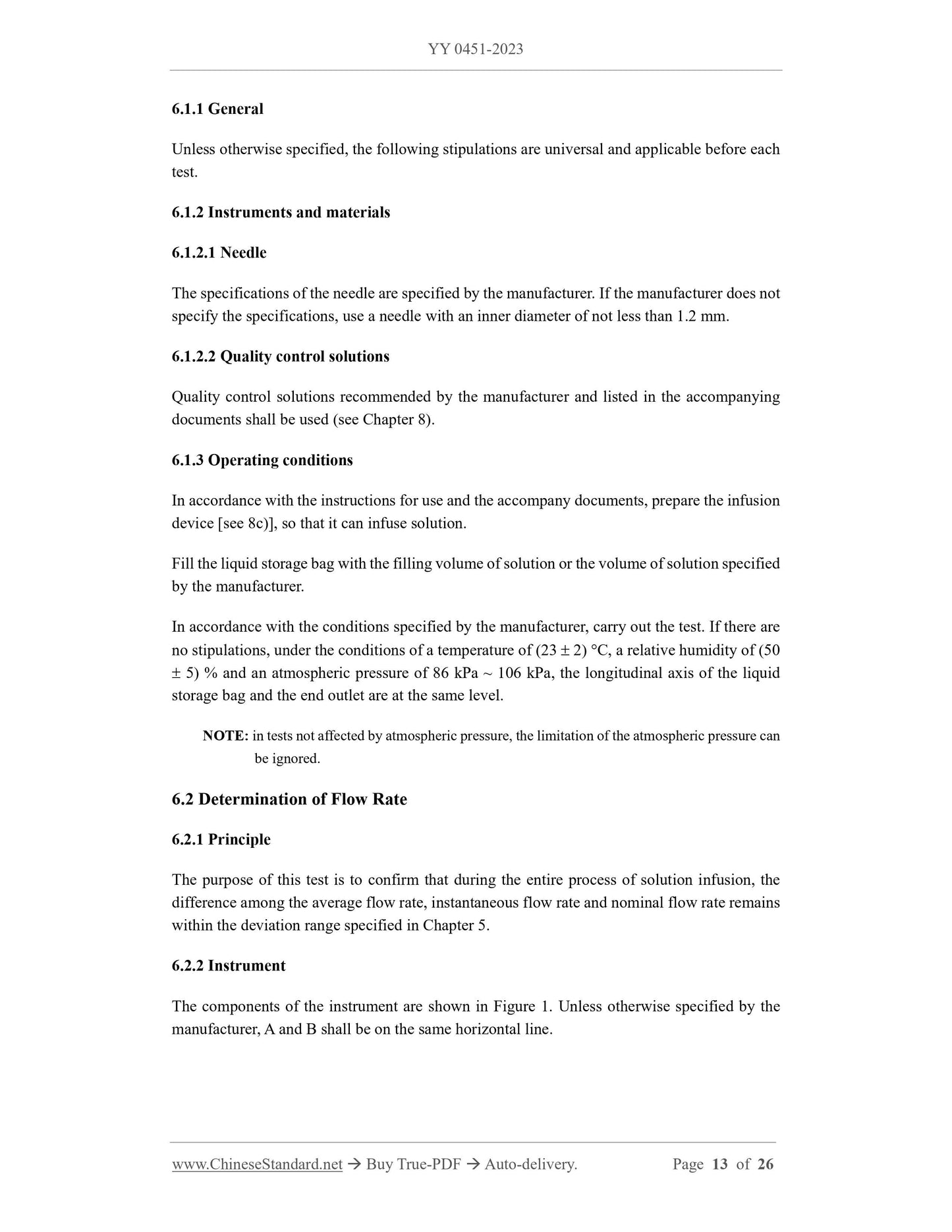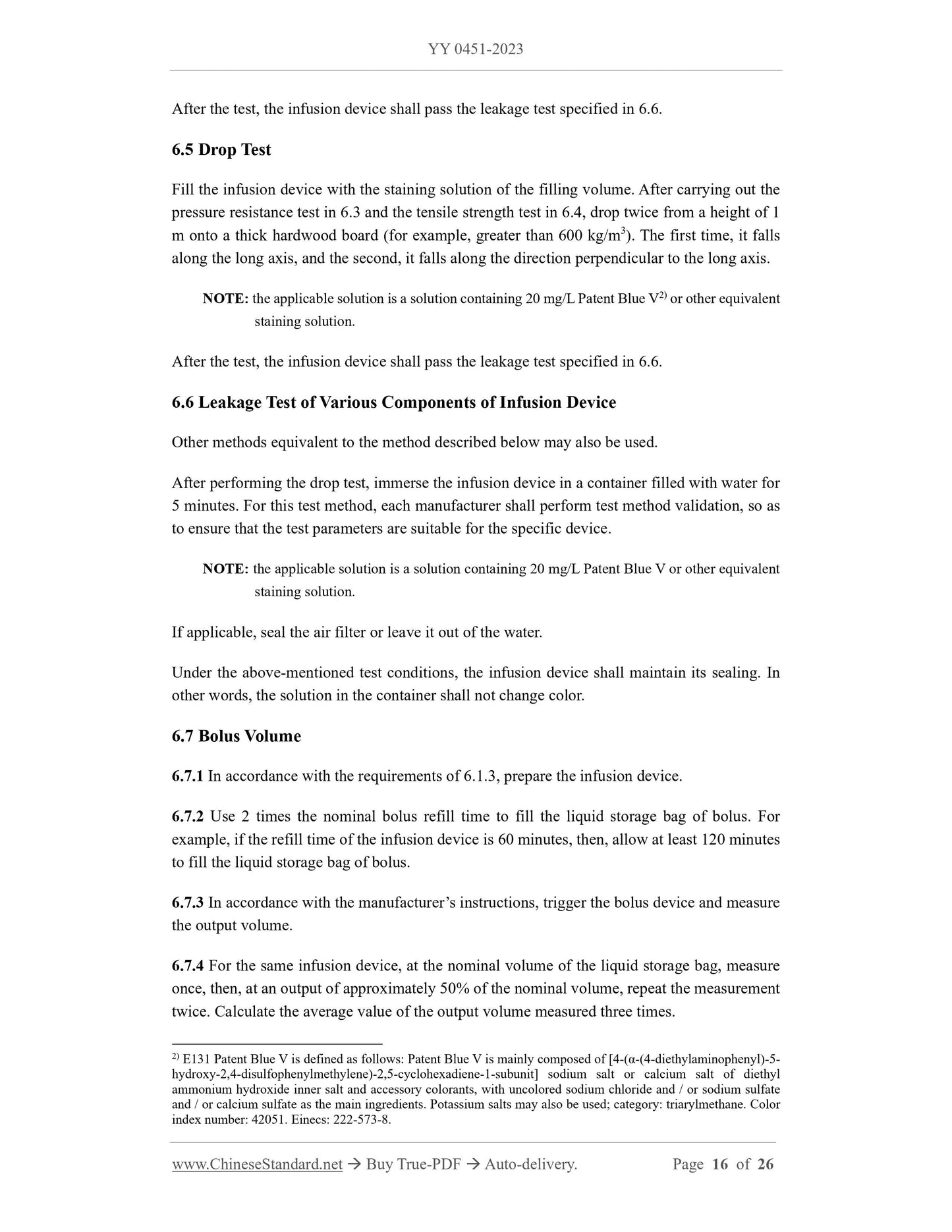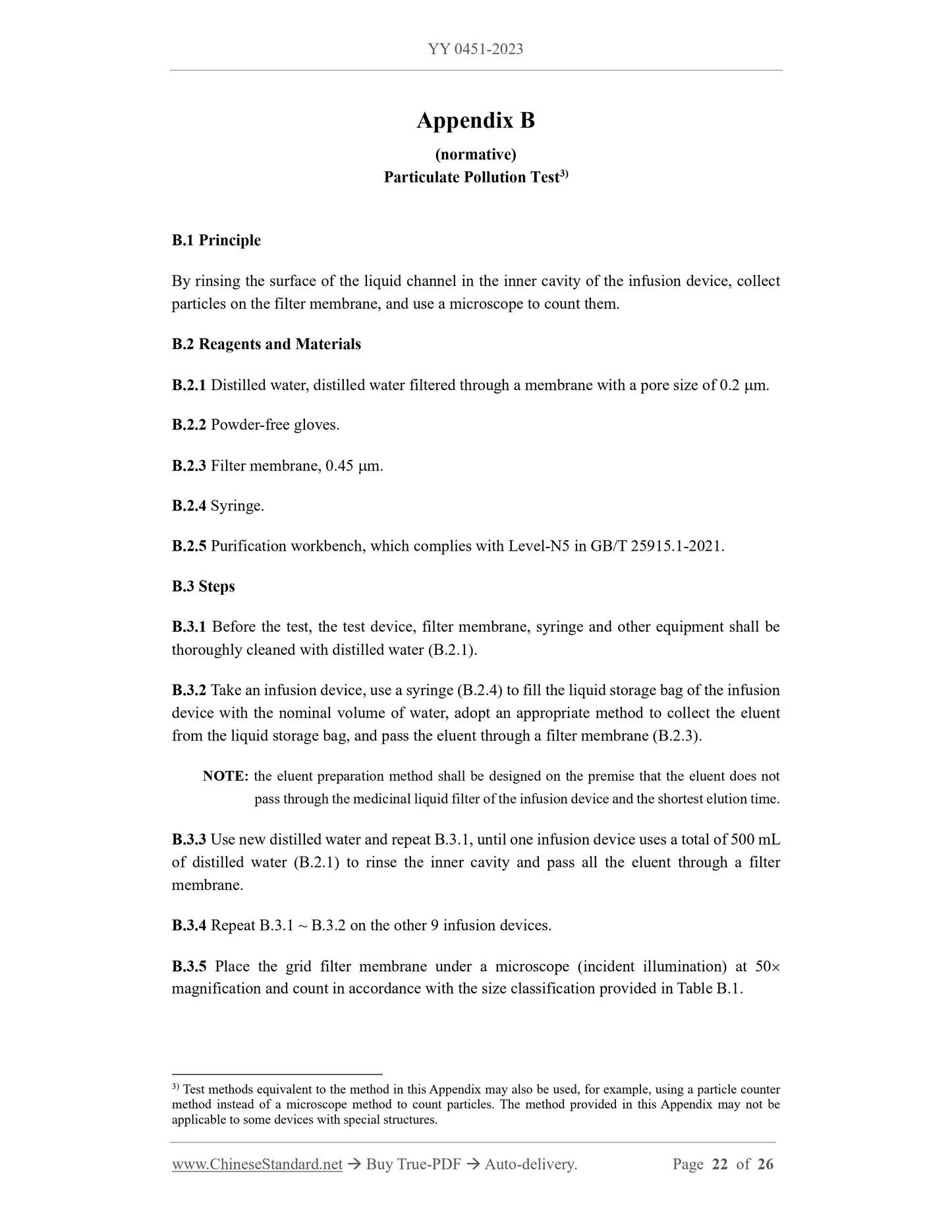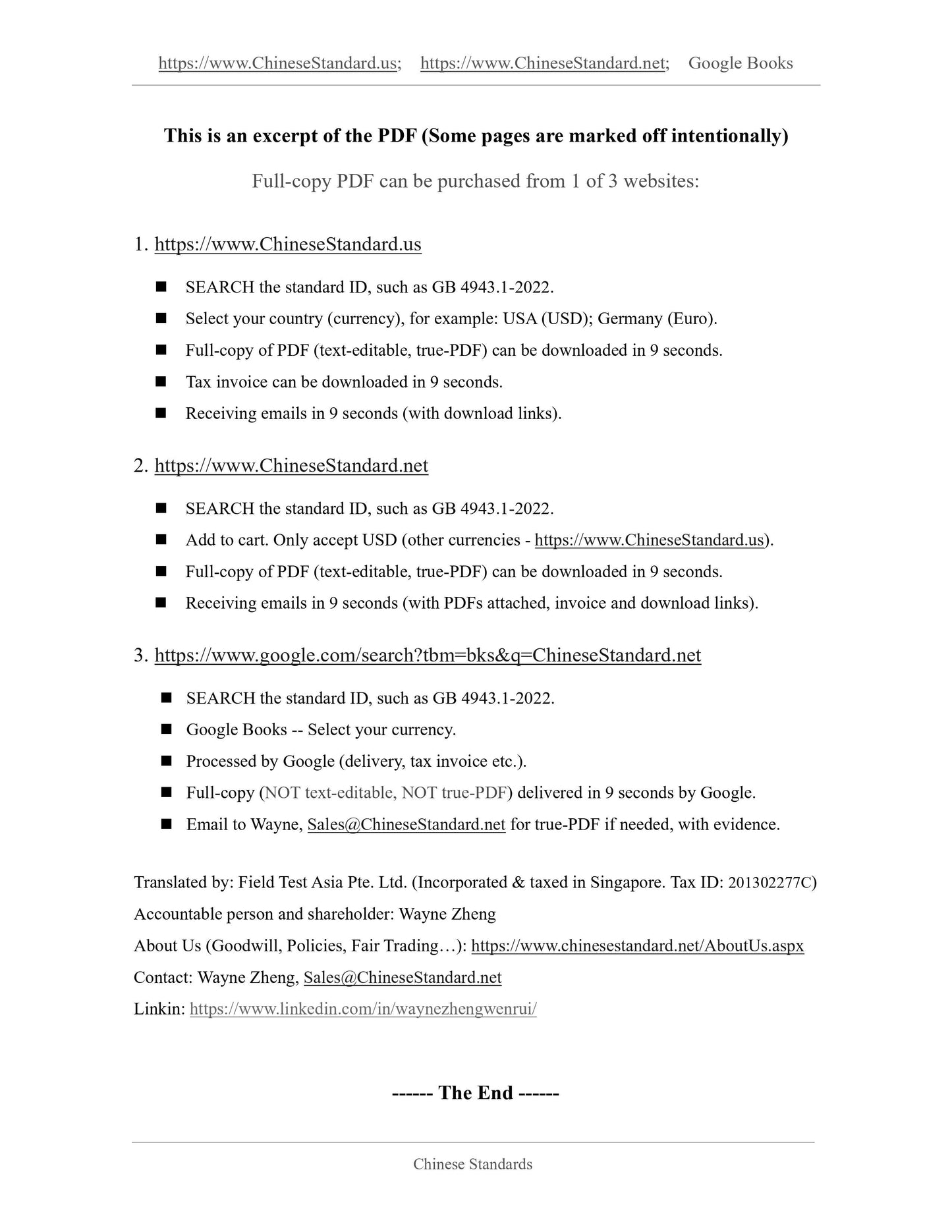1
/
of
11
PayPal, credit cards. Download editable-PDF and invoice in 1 second!
YY 0451-2023 English PDF
YY 0451-2023 English PDF
Regular price
$260.00 USD
Regular price
Sale price
$260.00 USD
Unit price
/
per
Shipping calculated at checkout.
Couldn't load pickup availability
Delivery: 3 seconds. Download true-PDF + Invoice.
Get QUOTATION in 1-minute: Click YY 0451-2023
Historical versions: YY 0451-2023
Preview True-PDF (Reload/Scroll if blank)
YY 0451-2023: Portable infusion devices for single use - Non electrically driven
YY 0451-2023
YY
PHARMACEUTICAL INDUSTRY STANDARD
OF THE PEOPLE’S REPUBLIC OF CHINA
ICS 11.080.01
CCS C 47
Replacing YY 0451-2010
Portable Infusion Devices for Single Use - Non Electrically
Driven
(ISO 28620:2020, Medical Devices - Non-electrically Driven Portable Infusion
Devices, MOD)
ISSUED ON: SEPTEMBER 5, 2023
IMPLEMENTED ON: SEPTEMBER 15, 2026
Issued by: National Medical Products Administration
Table of Contents
Foreword ... 3
Introduction ... 5
1 Scope ... 6
2 Normative References ... 6
3 Terms and Definitions ... 7
4 General Requirements ... 9
5 Operating Requirements ... 12
6 Test Methods ... 12
7 Information That Shall Be on the Packaging and / or Product ... 17
8 Accompanying Documents ... 18
Appendix A (informative) Technical Differences between This Document and ISO
28620:2020, and Causes for the Differences ... 19
Appendix B (normative) Particulate Pollution Test ... 22
Bibliography ... 25
Portable Infusion Devices for Single Use - Non Electrically
Driven
1 Scope
This document specifies the basic requirements and corresponding test methods for portable
infusion devices for single use - non electrically driven (hereinafter referred to as the infusion
devices).
This document is applicable to infusion devices for continuous (fixed or adjustable) and / or
self-controlled delivery of fluids for neurological, intravascular or subcutaneous applications.
NOTE: the parts of neurological application include the spine, intrathecal or subarachnoid space,
ventricles, epidural space, epidural space or dural space. Neurological anesthetics can be
locally infused to affect large parts (for example, limbs) of the body and involve nerve
plexus blocks (for example, brachial plexus block or single nerve block). The neurological
application procedure involves a continuous infusion of local anesthetic into the wound.
This document does not apply to:
---Electrically driven or electrically controlled infusion devices covered by GB 9706.224;
---Devices for the delivery of discrete (bolus) medicinal liquids covered by the YY/T 1768
series for use by a single patient;
---Implanted devices;
---Enteral feeding pumps;
---Transcutaneous infusion devices;
---Devices whose infusion is not driven by the devices themselves or devices whose
infusion is driven by active intervention by the patient (for example, devices powered
solely by gravity).
2 Normative References
The contents of the following documents constitute indispensable clauses of this document
through normative references in the text. In terms of references with a specified date, only
versions with a specified date are applicable to this document. In terms of references without a
specified date, the latest version (including all the modifications) is applicable to this document.
GB/T 6682 Water for Analytical Laboratory Use - Specification and Test Methods (GB/T 6682-
2008, ISO 3696:1987, MOD)
GB 8368 Infusion Sets for Single Use - Gravity Feed (GB 8368-2018, ISO 8536-4:2010, MOD)
GB/T 14233.1-2022 Test Methods for Infusion, Transfusion, Injection Equipment for Medical
Use - Part 1: Chemical Analysis Methods
GB/T 16886.1 Biological Evaluation of Medical Devices - Part 1: Evaluation and Testing within
a Risk Management Process (GB/T 16886.1-2022, ISO 10993-1:2018, IDT)
YY 0286.1-2019 Infusion Sets for Special Purpose - Part 1: Infusion Sets for Single Use with
Micropore Filters
YY/T 0466.1 Medical Devices - Symbols to be Used with Medical Device Labels, Labelling
and Information to be Supplied - Part 1: General Requirements (YY/T 0466.1-2016, ISO
15223-1:2012, IDT)
YY/T 0916.1 Small-bore Connectors for Liquids and Gases in Healthcare Applications - Part
1: General Requirements (YY/T 0916.1-2021, ISO 80369-1:2018, IDT)
YY/T 0916.6 Small-bore Connectors for Liquids and Gases in Healthcare Applications - Part
6: Connectors for Neuraxial Applications (YY/T 0916.6-2022, ISO 80369-6:2016, IDT)
ISO 80369-7 Small-bore Connectors for Liquids and Gases in Healthcare Applications - Part 7:
Connectors for Intravascular or Hypodermic Applications1)
3 Terms and Definitions
The following terms and definitions are applicable to this document.
3.1 bolus
Input a certain volume of medicinal fluid in a short time.
3.2 bolus refill time
The time required to refill an empty bolus device to the bolus volume.
3.3 nominal bolus refill time
The bolus refill time (3.2) marked on the infusion device or its packaging.
3.4 filling volume
The nominal volume (3.10) plus the residual volume (3.5).
3.5 residual volume
After the infusion is completed, the volume of residual fluid in the infusion device and its
1) YY/T 0916.7, which equivalently adopts ISO 80369-7:2021, is about to be issued.
4 General Requirements
4.1 Composition
The infusion device shall include the following components:
---Non-electrical energy-driven component for the infusion of medicinal fluids;
---Flow-limiting device;
---Liquid storage bag used to hold infused medicinal fluids;
---Medicinal fluid filter on the medicinal liquid infusion channel.
NOTE 1: these components are either integral or separated.
The infusion device may also include one or more of the following components (non-exhaustive
list):
---Flow regulating system;
---Liquid filling port, preferably equipped with an anti-backflow valve;
NOTE 2: the liquid filling port is only used for filling medicinal fluids and shall comply with the
female Luer connectors in YY/T 0916.7.
---The end of the pipeline complies with the locking connectors in YY/T 0916.6 or YY/T
0916.7, so as to satisfy the requirements for the intended use;
---Flow-stop clamp, if necessary;
---Sterile protective sleeves, for example, Luer caps, on the end of the pipeline and the
filling port;
---An infusion system that performs bolus within the infusion time range in a mode of
controlling the maximum infusion volume;
---Protective device for the liquid storage bag, so as to prevent the medicinal liquids from
flowing out when the liquid storage bag ruptures or leaks (shall satisfy the leakage test
of 6.5 and 6.6);
---The mode, in which, the end point of infusion is indicated;
NOTE 3: achieved through visual, auditory or other prompts.
---Infusion pipeline;
---Exhaust device.
4.2 Materials
The materials used in parts that come into contact with medicinal liquids shall undergo
biological evaluation in accordance with the relevant parts of GB/T 16886.1.
4.3 Design and Characteristics
4.3.1 General principle
The infusion device shall be designed to deliver in accordance with the nominal flow rate (5.1).
4.3.2 Connectors
If applicable, the connectors of the liquid filling port shall comply with the female locking
connectors in YY/T 0916.6 or YY/T 0916.7.
If connectors are used at the end of the pipeline, they shall comply with the male locking
connectors in YY/T 0916.6 or YY/T 0916.7, so as to satisfy the requirements for the intended
use.
All connectors on the infusion device used to connect to other medical devices or accessories
shall be designed in accordance with YY/T 0916.1, YY/T 0916.6 or YY/T 0916.7, so as to
satisfy the requirements for the intended use.
NOTE: YY/T 0916.6 and YY/T 0916.7 specify the materials, dimensional design and performance
requirements for the connectors. On the premise that the materials and designed
dimensions of the connectors satisfy the corresponding standards, t...
Get QUOTATION in 1-minute: Click YY 0451-2023
Historical versions: YY 0451-2023
Preview True-PDF (Reload/Scroll if blank)
YY 0451-2023: Portable infusion devices for single use - Non electrically driven
YY 0451-2023
YY
PHARMACEUTICAL INDUSTRY STANDARD
OF THE PEOPLE’S REPUBLIC OF CHINA
ICS 11.080.01
CCS C 47
Replacing YY 0451-2010
Portable Infusion Devices for Single Use - Non Electrically
Driven
(ISO 28620:2020, Medical Devices - Non-electrically Driven Portable Infusion
Devices, MOD)
ISSUED ON: SEPTEMBER 5, 2023
IMPLEMENTED ON: SEPTEMBER 15, 2026
Issued by: National Medical Products Administration
Table of Contents
Foreword ... 3
Introduction ... 5
1 Scope ... 6
2 Normative References ... 6
3 Terms and Definitions ... 7
4 General Requirements ... 9
5 Operating Requirements ... 12
6 Test Methods ... 12
7 Information That Shall Be on the Packaging and / or Product ... 17
8 Accompanying Documents ... 18
Appendix A (informative) Technical Differences between This Document and ISO
28620:2020, and Causes for the Differences ... 19
Appendix B (normative) Particulate Pollution Test ... 22
Bibliography ... 25
Portable Infusion Devices for Single Use - Non Electrically
Driven
1 Scope
This document specifies the basic requirements and corresponding test methods for portable
infusion devices for single use - non electrically driven (hereinafter referred to as the infusion
devices).
This document is applicable to infusion devices for continuous (fixed or adjustable) and / or
self-controlled delivery of fluids for neurological, intravascular or subcutaneous applications.
NOTE: the parts of neurological application include the spine, intrathecal or subarachnoid space,
ventricles, epidural space, epidural space or dural space. Neurological anesthetics can be
locally infused to affect large parts (for example, limbs) of the body and involve nerve
plexus blocks (for example, brachial plexus block or single nerve block). The neurological
application procedure involves a continuous infusion of local anesthetic into the wound.
This document does not apply to:
---Electrically driven or electrically controlled infusion devices covered by GB 9706.224;
---Devices for the delivery of discrete (bolus) medicinal liquids covered by the YY/T 1768
series for use by a single patient;
---Implanted devices;
---Enteral feeding pumps;
---Transcutaneous infusion devices;
---Devices whose infusion is not driven by the devices themselves or devices whose
infusion is driven by active intervention by the patient (for example, devices powered
solely by gravity).
2 Normative References
The contents of the following documents constitute indispensable clauses of this document
through normative references in the text. In terms of references with a specified date, only
versions with a specified date are applicable to this document. In terms of references without a
specified date, the latest version (including all the modifications) is applicable to this document.
GB/T 6682 Water for Analytical Laboratory Use - Specification and Test Methods (GB/T 6682-
2008, ISO 3696:1987, MOD)
GB 8368 Infusion Sets for Single Use - Gravity Feed (GB 8368-2018, ISO 8536-4:2010, MOD)
GB/T 14233.1-2022 Test Methods for Infusion, Transfusion, Injection Equipment for Medical
Use - Part 1: Chemical Analysis Methods
GB/T 16886.1 Biological Evaluation of Medical Devices - Part 1: Evaluation and Testing within
a Risk Management Process (GB/T 16886.1-2022, ISO 10993-1:2018, IDT)
YY 0286.1-2019 Infusion Sets for Special Purpose - Part 1: Infusion Sets for Single Use with
Micropore Filters
YY/T 0466.1 Medical Devices - Symbols to be Used with Medical Device Labels, Labelling
and Information to be Supplied - Part 1: General Requirements (YY/T 0466.1-2016, ISO
15223-1:2012, IDT)
YY/T 0916.1 Small-bore Connectors for Liquids and Gases in Healthcare Applications - Part
1: General Requirements (YY/T 0916.1-2021, ISO 80369-1:2018, IDT)
YY/T 0916.6 Small-bore Connectors for Liquids and Gases in Healthcare Applications - Part
6: Connectors for Neuraxial Applications (YY/T 0916.6-2022, ISO 80369-6:2016, IDT)
ISO 80369-7 Small-bore Connectors for Liquids and Gases in Healthcare Applications - Part 7:
Connectors for Intravascular or Hypodermic Applications1)
3 Terms and Definitions
The following terms and definitions are applicable to this document.
3.1 bolus
Input a certain volume of medicinal fluid in a short time.
3.2 bolus refill time
The time required to refill an empty bolus device to the bolus volume.
3.3 nominal bolus refill time
The bolus refill time (3.2) marked on the infusion device or its packaging.
3.4 filling volume
The nominal volume (3.10) plus the residual volume (3.5).
3.5 residual volume
After the infusion is completed, the volume of residual fluid in the infusion device and its
1) YY/T 0916.7, which equivalently adopts ISO 80369-7:2021, is about to be issued.
4 General Requirements
4.1 Composition
The infusion device shall include the following components:
---Non-electrical energy-driven component for the infusion of medicinal fluids;
---Flow-limiting device;
---Liquid storage bag used to hold infused medicinal fluids;
---Medicinal fluid filter on the medicinal liquid infusion channel.
NOTE 1: these components are either integral or separated.
The infusion device may also include one or more of the following components (non-exhaustive
list):
---Flow regulating system;
---Liquid filling port, preferably equipped with an anti-backflow valve;
NOTE 2: the liquid filling port is only used for filling medicinal fluids and shall comply with the
female Luer connectors in YY/T 0916.7.
---The end of the pipeline complies with the locking connectors in YY/T 0916.6 or YY/T
0916.7, so as to satisfy the requirements for the intended use;
---Flow-stop clamp, if necessary;
---Sterile protective sleeves, for example, Luer caps, on the end of the pipeline and the
filling port;
---An infusion system that performs bolus within the infusion time range in a mode of
controlling the maximum infusion volume;
---Protective device for the liquid storage bag, so as to prevent the medicinal liquids from
flowing out when the liquid storage bag ruptures or leaks (shall satisfy the leakage test
of 6.5 and 6.6);
---The mode, in which, the end point of infusion is indicated;
NOTE 3: achieved through visual, auditory or other prompts.
---Infusion pipeline;
---Exhaust device.
4.2 Materials
The materials used in parts that come into contact with medicinal liquids shall undergo
biological evaluation in accordance with the relevant parts of GB/T 16886.1.
4.3 Design and Characteristics
4.3.1 General principle
The infusion device shall be designed to deliver in accordance with the nominal flow rate (5.1).
4.3.2 Connectors
If applicable, the connectors of the liquid filling port shall comply with the female locking
connectors in YY/T 0916.6 or YY/T 0916.7.
If connectors are used at the end of the pipeline, they shall comply with the male locking
connectors in YY/T 0916.6 or YY/T 0916.7, so as to satisfy the requirements for the intended
use.
All connectors on the infusion device used to connect to other medical devices or accessories
shall be designed in accordance with YY/T 0916.1, YY/T 0916.6 or YY/T 0916.7, so as to
satisfy the requirements for the intended use.
NOTE: YY/T 0916.6 and YY/T 0916.7 specify the materials, dimensional design and performance
requirements for the connectors. On the premise that the materials and designed
dimensions of the connectors satisfy the corresponding standards, t...
Share
